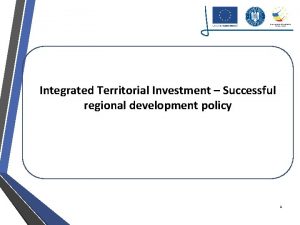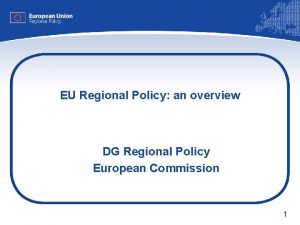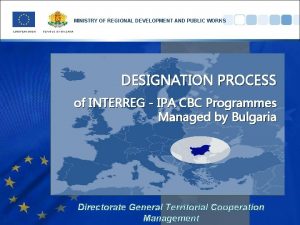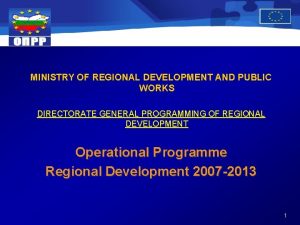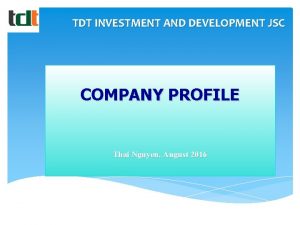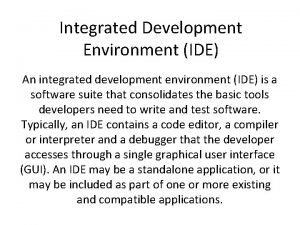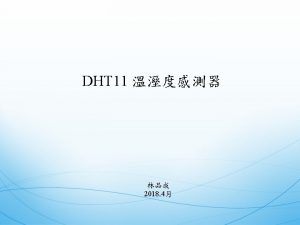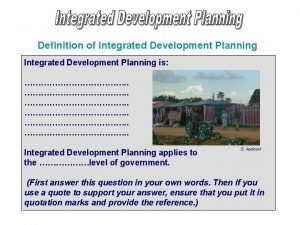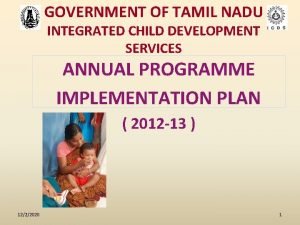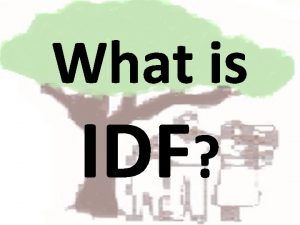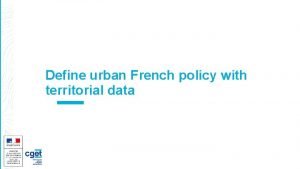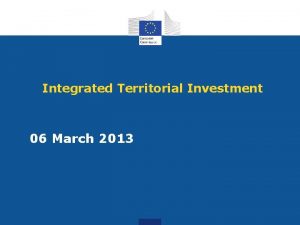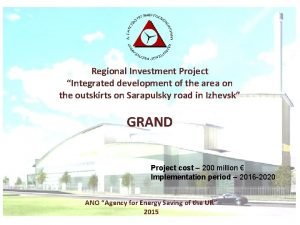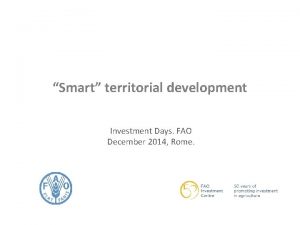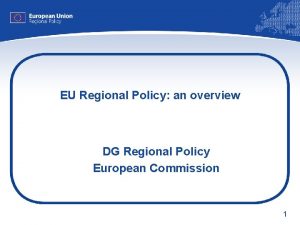Integrated Territorial Investment Successful regional development policy 1




















- Slides: 20

Integrated Territorial Investment – Successful regional development policy 1

MAIN CHARACTERISTICS OF THE NEW FRAMEWORK FOR COHESION POLICY 2021 -2027 Strategic approach- 5 objectives of the Cohesion Policy A smarter Europe A more connected Europe A Europe closer to citizens A greener Europe A more social Europe

MAIN CHARACTERISTICS OF THE NEW FRAMEWORK FOR COHESION POLICY 2021 -2027 Architecture and funds 1. Investments for jobs and growth 2. European Territorial Cooperation Financed from ERDF, ESF+ and CF Financed from ERDF 3

MAIN CHARACTERISTICS OF THE NEW FRAMEWORK FOR COHESION POLICY 2021 -2027 Type of Regions 1. Less developed regions whose GDP per capita is less than 75% of the EU-27's average GDP 2. Regions in transition whose GDP per capita is between 75% and 100% of the EU-27 average GDP 3. More developed regions whose GDP per capita is over 100% of the EU-27 average GDP 4

MAIN CHARACTERISTICS OF THE NEW FRAMEWORK FOR COHESION POLICY 2021 -2027 Financial aspects (MFF) § Main type - grants § Cofinance at national level: Ø 70% for less developed regions and for the Cohesion Fund Ø 40% for more developed regions. Ø Annual prefinance – 0, 5 % from the total amount of support from funds It is proposed to systematize and increase the use of simplified cost options (lump sum reimbursement, standard scales for unit costs or lump sums, etc. ). VAT - is not eligible for a contribution from the funds, except for operations whose total cost is less than EUR 5 000. Decommittment - „N + 2” rule 5

Cooperation mechanism Managing auhorities - Lessons learned - Good practice examples - Simplification Line Ministries - Strategies and strategic documents - Enabling conditions - Investment needs Ministry of European Funds External support (consultants) - strategic documents (PA & OPs) - Reports regarding enabling conditions -Implementation of the partnership principle (public debates) Relevant socio-economic partners - Comments on strategic documents - Investment priorities/needs

Cohesion Policy 2021 -2017 allocation ØThe allocation of Cohesion Policy for the period 2021 -2027 is 331 billion euros ØThe current MFF allocation proposal for Romania is € 30. 60 billion, as follows: q ESF+: 8, 385 billion euro q ERDF: 17, 323 billion euro q CF: 4, 499 billion euro ØProposed allocation * for each PO (excluding the amounts allocated for TA): q PO 1: 5, 992 billion euro q PO 2: 5, 459 billion euro q PO 3: 5, 945 billion euro q PO 4: 9, 673 billion euro q PO 5: 1, 027 billion euro * After reallocating 5% from the ESF to the ERDF and taking into account thematic concentration 7

Integrated Territorial Investments(ITI) • European funds support integrated territorial development through local and territorial development strategies implemented through ITI territorial instruments, DLRC or other nationally developed instruments • ITI - an optional tool for territorial development that makes it possible to combine the resources from several European funds, within the priority axes of one or more Operational Programs (OPs) (OPs Key elements of an Integrated Territorial Investment the existence of a clearly identified territory integrated development strategy package of priorities and projects system of governance 8

Integrated Territorial Investments (ITI) the existence of a clearly identified territory - Implementation at any type of level: a region, a functional area, a municipality, a neighborhood or any other sub-national division - May cross administrative boundaries, because it’s addressing specific requirements of an area that can improve the efficiency of public interventions - Increased integration of sectoral policies and interventions at the level of the identified territory integrated development strategy - Focus on funding and prioritising interventions - Thematic integration- integrating strategic objectives from several local strategies, including investment priorities from several policy objectives as well as integrating public and private funding flows - Assume locally the integrated development strategy 9

Integrated Territorial Investments (ITI) package of priorities and projects Establishing priorities at the local level and successfully implementing the projects requires: - modifying working practices and developing the capacity to provide and implement the territorial development policy - facilitating a strategic way of thinking - applying the prioritisation of the actions - concentrating resources locally system of governance The vertical and horizontal relationships between the partners must be clearly established and the responsibilities shared The ITI governance system must be at least responsible for selecting interventions from public funds 10

Challenges in implementing an ITI ücomplexity of the instrument - Financing from several funds, including national and local üpossible differences between the objectives and priorities identified at national level with the needs identified at local / territorial level ülimited material resources at the level of the local authorities necessary for the preparation and implementation of the projects ülow operational capacity of local actors (knowledge level, project development, budget management, team work) üdifferences between OPs from which they are financed - complex rules in implementation ülimited involvement of partners üthe difficulty of establishing the level of financing needed for implementation - because of the funding from several funds (many funds) 11

Conclusions ITI - an optional tool for territorial development and its use should be made only in very well-founded situations, based on some Clear criteria The existence of a territory established on the basis of common specific characteristics (the same types of problems or opportunities, economic, geographical factors, etc. ) Integrated Development Strategy - the main components: q general objective qan analysis of the development needs and the potential of the area q 12

Conclusions q. The existence of a partnership agreement elaborated and signed by all the authorities involved in ITI, which will ensure the organisation and operationalisation of the governance system. q. There are no separate amounts for ITI financing compared to the budget granted to RO in MFF 2021 -2027 q. All the rules applicable to European funds also apply to ITIs, including those related to thematic focus on priority areas q. There is NO DEROGATION, neither in the selection, nor in the implementation, for ITI projects, compared to those applicable to the operational programs from which the financing is made !!!!! q. The amounts allocated unpaid will be redistributed to the OP 13

Community- Led Local Development CLLD concept ü European tool for promoting integrated development and community involvement in local development by forming a local partnership (Local Action Group (LAG) and implementing local development strategies (SDL) ü TERRITORIES on which community lead actions can be applied are: § a city, small or medium, and the polarized rural area in the vicinity; § a peripheral rural area devoid of urban centers; § an area along a river sector or around a lake with fishing resources; § a neighborhood within a city; § several neighborhoods that fall into a common typology; § a neighboring rural area or the peri-urban edge around a large city, or around an estuary, lake or river basin. 14

Community -Led Local Development The CLLD tool can be used in areas such as: • solving problems in local labor markets • solving problems regarding vulnerable social groups such as the Roma or migrant population • development of economic clusters at local level • creation / renovation of social shelters • improving rural services • small infrastructure development / rehabilitation • improvement of environmental conditions. 15

Community- Led Local Development Proposal for the post-2020 CLLD approach Must be taken into consideration: • the new provisions for territorial instruments at the level of post-2020 regulations - the possibility of LEAD-FUND • current experience: the procedural steps taken, the framework documents elaborated • the experience gained locally • the large ESF allocation available to Romania (EUR 8. 4 billion) and the possibility of financing the ESF under a more Social Europe only, on the one hand and, on the other hand, the need to meet thematic concentration criteria for integrated urban development (6%) within a Europe closer to the citizens. • persistence of the problems of marginalization at the city level, (but also the need for support for development, for creating a certain standard of living, for developing the business environment) 16

Community -Led Local Development It is proposed a dual use of the CLLD at the city level: Continuing the current approach, by implementing the CLLD mechanism at the level of marginalized communities in urban areas) PRIORITY Reducing the risk of poverty of vulnerable communities by implementing integrated measures through the CLLD tool - It is recommended that the ESF become Lead Fund for the dedicated LDSs of marginalized urban communities - in the conditions of orientation towards financing of the Strategies for the urban marginalized communities with priority from the ESF and their classification in OP 4 it is important to focus LDS on ESF interventions. 17

Integrated Territorial Investments The only Integrated Territorial Investment for the 2014 -2020 programming period implemented in Romania, according to the Partnership Agreement, is based on the Integrated Strategy for the Sustainable Development of the Danube Delta; The strategy was elaborated by the MRDPA with assistance from the World Bank and with financial support from the POAT 2007 -2013, which was approved by GD 602/2016. 1, 661 Projects submitted, of which: 908 Projects contracted 1, 800 1. 368. 756. 896 Euro projects submitted, of which: 826. 194. 326 Euro projects contracted 1, 600, 000 1, 661 1, 600 1, 400, 000 1, 400 1, 200, 000 1, 200 1, 000, 000 1, 000 800 600 400 200 0 908 1, 368, 756, 89 6 826, 194, 326 800, 000 600, 000 400, 000 200, 000 0 18

Integrated Territorial Investments 1386 Approved projects, of which the allocation of ITI: 792, 540, 268. 28 Euro 70% From the amount allocated through the ITI mechanism The territory of the ITI Danube Delta has a budget of 1. 114 billion Euro, allocated by E. C. 19

Thank you! Mihaela Virginia Toader Secretary of State, Ministry of European Funds • • http: //mfe. gov. ro/ https: //www. facebook. com/Ministerul. Fondurilor. Europene/ https: //twitter. com/mfe_romania https: //www. instagram. com/mfe. gov. ro/
 Integrated territorial investments
Integrated territorial investments Rudolf niessler
Rudolf niessler Fixed investment and inventory investment
Fixed investment and inventory investment Dg regional policy
Dg regional policy Hse risk management policy
Hse risk management policy Electronic commerce security
Electronic commerce security Integrated maritime policy
Integrated maritime policy Headwaters regional development commission
Headwaters regional development commission Ministry of regional development and public works
Ministry of regional development and public works Ministry of regional development and public works
Ministry of regional development and public works Entrepreneurship and regional development
Entrepreneurship and regional development Pre-investment phase
Pre-investment phase Tdt investment and development jsc
Tdt investment and development jsc What is the scenario the ide generally required?
What is the scenario the ide generally required? Arduino integrated development environment
Arduino integrated development environment 3 reasons for supportive stance
3 reasons for supportive stance Integrated development planning definition
Integrated development planning definition Cpi crisis development model
Cpi crisis development model Integrated child development
Integrated child development What is idf
What is idf Integrated residential development programme
Integrated residential development programme
